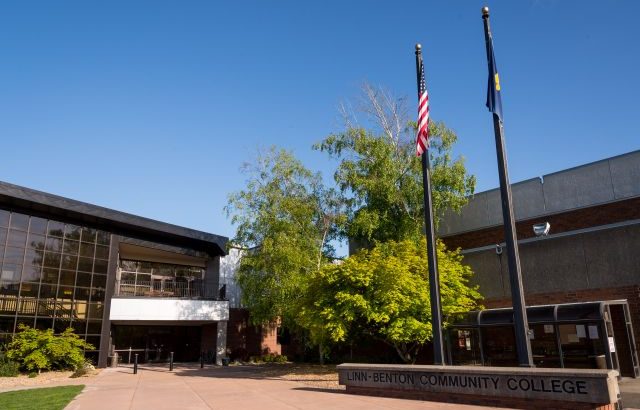Ministerio de Educación de Estados Unidos/08 de julio de 2016
Resumen: La diversidad de todo tipo – raza, etnia, origen nacional y la situación económica, la estructura familiar y de identidad de género, orientación sexual y estado de discapacidad, religión o idioma nativo – beneficia a todos los estudiantes. La diversidad no es una sutileza, sino una necesidad. En honor al Mes de la Herencia Inmigrante, estas instituciones puedan compartir sus historias personales en sus propias palabras:
Celebrando Nustra Diversidad Patrimonio y Estudiantes
Mi nombre es Alfonso Treto y yo soy un maestro de escuela mexicana-americano y pública de primera generación. Venir a los Estados Unidos, mis padres tenían que luchar por el sueño americano. Mi madre hizo hincapié en la importancia de una educación. Me criaron con la idea de que una educación adecuada crearía muchas oportunidades para mí.
Alfonso Treto
Puedo decir que la enseñanza es una profesión que me eligió. Como ayudante de un profesor, fui testigo de los estudiantes están siendo tratados de manera diferente lo que me motivó a convertirse en un maestro y dar una oportunidad a todos los estudiantes independientemente de su origen. Muchos de los estudiantes me ven como un modelo a seguir debido a las similitudes de crianza.
Trabajando para el Programa de Educación Migrante M-DCPS Título I que he tenido el privilegio de servir a las familias de orígenes muy diversos. Recientemente ha habido una afluencia de los menores no acompañados que han hecho un peligroso viaje por sí mismos, así como escapar de la violencia y buscan protección en busca de una vida mejor. Algunos estudiantes tienen miedo de lo que está pasando políticamente sin embargo han aprendido a respetar y celebrar sus diferencias. Todos los estudiantes saben que con determinación ( ganas) que pueden superar cualquier obstáculo.
Alfonso Treto enseña a los estudiantes de la escuela secundaria en el programa de educación migrante Título I en Miami-Dade en Miami, Florida.
Sólo deseo vivo para exhalar, si no respirar en libertad
Reclutado en dos ocasiones por los organismos con sede en Filipinas para cubrir la escasez de mano de obra profesor, primero en Texas y más tarde en Maryland, Rogie ha enseñado en las escuelas estadounidenses para un total combinado de 20 años. Su primer intento de la inmigración resultó ser un esquema de tráfico de seres humanos por la agencia que primero lo reclutó.
Rogie Legaspi
A la espera de exhalar del proceso de inmigración prolongada, que aprovechó su terrible experiencia en su trabajo con un consejo de múltiples partes interesadas para co-autor de «El Código de la Ética contratación internacional y contratación de maestros», un documento que guía las mejores prácticas para la contratación y el empleo de los profesores inmigrantes. Todos los días, que anima a sus estudiantes a prometer lealtad a la bandera de Estados Unidos, aun cuando no es capaz de hacer lo mismo que un trabajador temporal. Sus estudiantes (y sus hijos nacidos en Estados Unidos) pregunta: «¿Por qué haces comprometámonos pero no lo hace usted mismo?» Después de tantos años de enseñanza consumado, mientras que luchan sin descanso como un defensor de inmigrantes maestro, espera que algún día todos los maestros de inmigrantes que eligen pueden ser capaces de unirse con orgullo a sus estudiantes en la prenda también. Entonces, tal vez, todos ellos podrían atreverse a parar justo anhelo de exhalar, pero respirar verdaderamente libres.
Rogie Legaspi enseña 7º grado en Ciencias de la Vida / Escuela Media Hamilton Primaria en el Sistema de Escuelas Públicas de Baltimore en Baltimore, Maryland.
Decidido a hacer una diferencia en las vidas de mis estudiantes
Remigio Willman
Las experiencias de vida moldea a los individuos, y debido a experiencias que he perseverado a través de mi viaje desde México a los Estados Unidos, sé que todo el mundo tiene el potencial para tener éxito en bruto. Después de varios años de trabajar en varias escuelas públicas, que sirve de necesidad inmediata, las poblaciones en riesgo, incluyendo estudiantes migrantes y estudiantes diversos, siento una urgencia y el compromiso para hacer frente a las necesidades de mis estudiantes y sus familias. Yo trabajo continuamente para fortalecer mis habilidades para hacer frente a estos obstáculos. También trabajo en el fortalecimiento de estas habilidades en otros maestros. Crear oportunidades equitativas de educación para todos los niños en nuestra sociedad, es un imperativo moral para la cohesión social y una democracia fuerte. Como maestro que emigró a este país me siento una responsabilidad extremadamente importante para servir como un ejemplo para mis alumnos de lo que es posible cuando usted está decidido y trabaja duro. En los Estados Unidos si se trabaja duro, junto con su comunidad para crear oportunidades para todos, a salir adelante y no hace ninguna diferencia donde vienes. Nosotros, los inmigrantes que hicieron de este país nuestro hogar sentimos orgullosos de decir que esto sólo puede ocurrir en Estados Unidos.
Remigio Willman es una maestra de 3er grado en la Escuela Primaria Askew en el Distrito Escolar Independiente de Houston en Houston, Texas.
Aprender a vivir sin miedo
Nací en Guanajuato, México. Tenía nueve años cuando mi padre falleció y mi familia tuvo que emigrar a los Estados Unidos. Me perdí a mi abuela, echaba de menos mi lengua, mi cultura. Mi madre nos consuele diciendo que volvería a México dentro de unos meses.Sin embargo, pronto entré en el cuarto grado.
María Domínguez
En la escuela media, recuerdo haber visto a mi madre trabajar en dos empleos, volver a casa a altas horas de la noche y que lucha para criar a cuatro hijos sola. Yo sabía que un día me quería pagar su sacrificio y todo lo que ella estaba haciendo para nosotros. Mi sueño era convertirse en un profesional; Yo sabía que quería ser maestra y ayudar a otros con las mismas dificultades. El 15 de junio de 2012, que se convirtió de nuevo la esperanza de que el presidente Barack Obama anunció su orden ejecutiva que me permitió empezar a trabajar en mi escuela sueño. Como DACAmented 1 stmaestro bilingüe de grado servir a mi comunidad. Me preocupo por mis estudiantes y la comunidad, no estoy renunciando, esto es sólo un revés.
María Domínguez es un 1 st maestro de grado en la Escuela Primaria Rodríguez en el distrito de Austin en Austin, Texas.
Original News:
Diversity of all types – race, ethnicity, national origin and economic status, family structure and gender identity, sexual orientation and disability status, religion or native language – benefits all students. Diversity is not a nicety but a necessity.
In honor of Immigrant Heritage Month, these educators share their personal stories in their own words:
Celebrating Our Heritage & Student Diversity
My name is Alfonso Treto and I am a first generation Mexican-American and public school teacher. Coming to the United States, my parents had to struggle for the American dream. My mother emphasized the importance of an education. I was raised with the idea that a proper education would create many opportunities for me.

Alfonso Treto
I can say that teaching is a profession that chose me. As a teacher’s assistant, I witnessed students being treated differently which motivated me to become a teacher and provide an opportunity to all students regardless of their background. Many of the students see me as a role model because of the similarities of upbringing.
Working for M-DCPS Title I Migrant Education Program I have had the privilege of serving families from very diverse backgrounds. Recently there has been an influx of unaccompanied minors who have made a treacherous journey by themselves as well as escaping violence and seeking protection in search of a better life. Some students are fearful of what is going on politically however they have learned to respect and celebrate their differences. All students know that with determination (ganas) they can overcome any obstacle.
Alfonso Treto teaches high school students in the Title I Migrant Education Program in Miami-Dade County Public Schools in Miami, Florida.
Just Yearning to Exhale, If Not to Breathe Free
Recruited on two occasions by Philippine-based agencies to fill teacher labor shortages, first in Texas and later in Maryland, Rogie has now taught in American schools for a combined total of 20 years.
His initial immigration attempt turned out to be a human trafficking scheme by the agency that first recruited him.

Rogie Legaspi
While waiting to exhale from the protracted immigration process, he leveraged his awful experience in his work with a multi-stakeholder council to co-author “The Code for the Ethical International Recruitment and Employment of Teachers,” a document that guides best practices for the recruitment and employment of immigrant teachers.
Every day, he encourages his students to pledge allegiance to the American flag, even while he is unable to do the same as a temporary worker. His students (and his American-born children) ask, “Why do you make us pledge but you don’t do it yourself?”
After so many years of accomplished teaching, while struggling tirelessly as an immigrant teacher advocate, he hopes that someday all immigrant teachers who choose to may be able to proudly join their students in the pledge as well. Then perhaps, they could all dare to stop just yearning to exhale, but breathe free indeed.
Rogie Legaspi teaches 7th grade Life Science at Hamilton Elementary/Middle School in the Baltimore Public School System in Baltimore, Maryland.
Determined to Make a Difference in the Lives of My Students

Remigio Willman
Life experiences molds individuals, and because of experiences I have persevered through in my journey from Mexico to the United States, I know that everyone has the raw potential to succeed. After multiple years of working in various public schools, serving at-need, at-risk student populations, including migrant and diverse students, I feel an urgency and commitment to address the needs of my students and their families. I work continually to strengthen my skills to address these obstacles. I also work on strengthening these skills in other teachers. Creating educational equitable opportunities for every child in our society it is a moral imperative for social cohesion and a strong democracy.
As a teacher that immigrated to this country I feel an extremely important responsibility to serve as an example for my students of what is possible when you are determined and work hard. In America if you work hard along with your community to create opportunities for all, you get ahead and it makes no difference where are you coming from. We, the immigrants that made this country our home feel proud to say that this can only happen in America.
Remigio Willman is a 3rd grade teacher at Askew Elementary School in the Houston Independent School District in Houston, Texas.
Learning to Live without Fear
I was born in Guanajuato, Mexico. I was nine years old when my father passed away and my family had to migrate to the United States. I missed my grandma, I missed my language, my culture. My mother would comfort us by saying we would go back to Mexico in a few months. However, I soon entered fourth grade.

Maria Dominguez
In middle school, I remember seeing my mother work two jobs, coming home late at night and struggling to raise four children on her own. I knew one day I wanted to repay her sacrifice and everything she was doing for us. My dream was to become a professional; I knew I wanted to be a teacher and help others with the same struggles.
On June 15, 2012, I again became hopeful when President Barack Obama announced his executive order that allowed me to begin working at my dream school. As a DACAmented 1st grade bilingual teacher serving my community I’m heartbroken that the Supreme Court failed me, my students, and over 720,000 other DACAmented individuals that are proving President Obamas’s executive action work. I worry for my students and community, I’m not giving up, this is just a set-back.
Maria Dominguez is a 1st grade teacher at Rodriguez Elementary School in the Austin Independent School District in Austin, Texas.
Imagen: https://www.google.com/search?q=Immigrant+Heritage+Month:+In+Their+Own+Words&espv=2&biw=1366&bih=623&source=lnms&tbm=isch&sa=X&ved=0ahUKEwiWotrNpuLNAhXHKh4KHe0vBrkQ_AUIBigB#tbm=isch&q=immigrant+heritage+month+2016&imgrc=q1l1zkFMQO7eNM%3A
Tomado de:
http://blog.ed.gov/2016/06/immigrant-heritage-month-in-their-own-words/
 The share of high school students who are sexually active has fluctuated since 1991, ranging from 33 to 38 percent. In 2013, 34 percent of high school students reported being sexually active. Among black students, however, the proportion who reported they were sexually active decreased from 59 percent in 1991 to 41 percent in 2011, before increasing slightly to 42 percent in 2013. (Figure 1)
The share of high school students who are sexually active has fluctuated since 1991, ranging from 33 to 38 percent. In 2013, 34 percent of high school students reported being sexually active. Among black students, however, the proportion who reported they were sexually active decreased from 59 percent in 1991 to 41 percent in 2011, before increasing slightly to 42 percent in 2013. (Figure 1) Roughly a third of both male and female high school students reported being sexually active in 2013 (33 and 35 percent, respectively). In 2013, black male students were slightly more likely than black female students to report being sexually active (47 and 38 percent, respectively). There was no statistically significant difference in the prevalence of sexual activity between white or Hispanic males and their female peers. (Figure 2)
Roughly a third of both male and female high school students reported being sexually active in 2013 (33 and 35 percent, respectively). In 2013, black male students were slightly more likely than black female students to report being sexually active (47 and 38 percent, respectively). There was no statistically significant difference in the prevalence of sexual activity between white or Hispanic males and their female peers. (Figure 2) The likelihood of being sexually active increases with age, by eight to twelve percentage points each year. In 2013, 20 percent of ninth-grade students reported they were sexually active, compared with 49 percent of twelfth-graders. The difference was slightly greater among female students. (Figure 3)
The likelihood of being sexually active increases with age, by eight to twelve percentage points each year. In 2013, 20 percent of ninth-grade students reported they were sexually active, compared with 49 percent of twelfth-graders. The difference was slightly greater among female students. (Figure 3)

















 Users Today : 16
Users Today : 16 Total Users : 35460707
Total Users : 35460707 Views Today : 30
Views Today : 30 Total views : 3419854
Total views : 3419854